Fall Protection Strategies For Custom-Bilt Standing Seam Roof Systems
Posted by Howie Scarboro - CEO Fall Protection Distributors, LLC on Nov 21st 2025
See the Roof Anchor Compatibility Chart for Custom-Bilt Metals Standing Seam Panels.

Who Is Custom-Bilt Metals?
Custom-Bilt Metals, founded in 1974, has expanded from a regional gutter supplier into one of the most recognized manufacturers of metal roofing and wall panels across the western United States.
Headquartered in Chino, California, the company expanded steadily through the 1980s and 1990s and now serves customers from California to Alaska and Hawaii. Custom-Bilt Metals also maintains a strong presence throughout the Rocky Mountain region and parts of the Midwest.
Over five decades, the company shaped its reputation around reliability, on-site roll forming, and an extensive library of architectural metal products. Their catalog includes standing seam roofing, custom copper systems, coated Galvalume panels, soffit, fascia, coil, flat sheet, and over two thousand accessory items. With partnerships such as the long-standing collaboration with Vail Metal Systems, Custom-Bilt Metals continues to offer specialized materials for projects that require high-performance architectural metal.
Today, Custom-Bilt Metals remains known for consistent color-matching, dependable lead times, and strong warranty support. Contractors trust the brand because its products perform predictably in the field and because the company has never stopped improving its panel systems, coating technologies, and fabrication capabilities.
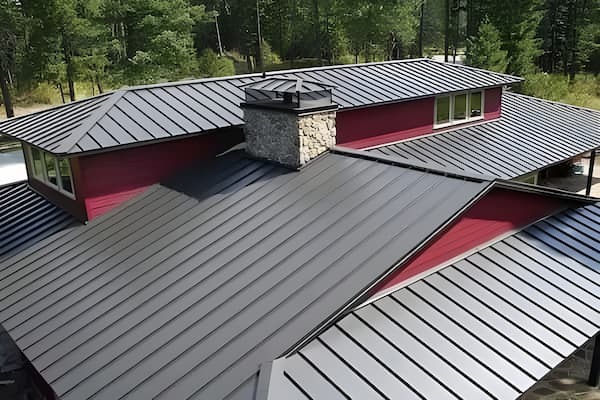
Why Are Non-Penetrating Fall Protection Anchors Required for Custom-Bilt Metals Standing Seam Roof Systems?
The safest tie-off method depends entirely on the seam shape, the strength of the base metal, the roof pitch, and the potential impact loads during a worker's fall arrest.
Custom-Bilt Metals manufactures mechanically-seamed, snaplock, nailstrip, and batten-cap standing seam systems. Each seam has different shapes and characteristics, so there is no single best fall protection strategy. Some panels can support seam-mounted anchors, and others must rely on ridge-mounted solutions.
Non-penetrating fall protection remains the only responsible approach for Custom-Bilt Metals panels because penetrations into the metal can disrupt thermal expansion and create water leaks that may not appear until long after the job is complete.
When the panel gauge and seam shape allow it, contractors can safely use non-penetrating SSRA products such as the SSRA1 Standing Seam Roof Anchor, SSRA2 Adjustable Roof Jack Adapters, SSRA3 Anchor Plates, and the SSRA HLL 100-Foot Temporary Horizontal Lifeline Kit. Facilities that see frequent rooftop access benefit from the Super Anchor 120-Foot Permanent Horizontal Lifeline Kit, which mounts to mechanically-seamed standing seam panels using non-penetrating anchors and riser posts for year-round protection.
For panels that cannot support seam-mounted anchors, such as 26-gauge steel, aluminum, copper, nailstrip, and batten-cap systems, the safest choice shifts to ridge-mounted fall protection. The Ridge Pro Steep Assist Anchor offers a completely non-penetrating approach by hooking over the ridge and providing a secure vertical lifeline tie-off before workers ever step onto the metal.
This guide walks safety managers, installers, and building owners through each Custom-Bilt Metals standing seam panel. It explains which fall protection systems best match that panel's seam shape and substrate.
CB-2000 Mechanical Panels
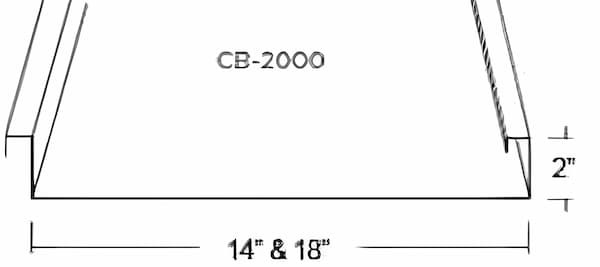
A structural 2-inch seam engineered for long spans and demanding environments.
The CB-2000 panel forms a tall, 2-inch mechanically-locked seam and is available in 14-inch and 18-inch widths. Contractors lean on this profile for large commercial buildings and other demanding projects. See the Roof Anchor Compatibility Chart for Custom-Bilt Metals CB-2000 Standing Seam Panels.
Custom-Bilt Metals produces the CB-2000 in 24-gauge and 26-gauge steel as well as aluminum and copper, giving designers a mix of structural choices and architectural finishes. Standard panel lengths reach up to 50 feet, reducing end laps and preserving a cleaner, more weather-tight system. With a minimum slope requirement of just 1/2:12, the CB-2000 delivers a durable mechanical seam that performs consistently on everything from low-slope commercial roofs to tall institutional buildings.
Fall Protection for CB-2000 Panels
Stronger CB-2000 24-gauge steel seams allow full use of the SSRA system.
When installers work on straight CB-2000 panels formed from 24-gauge steel, the entire SSRA non-penetrating system becomes available. The SSRA1 Standing Seam Roof Anchor grips the seam with stainless-steel set screws, creating a certified tie-off point without puncturing the metal. When crews need a stable platform for trim work or long ridge details, SSRA2 Adjustable Roof Jack Adapters mount on two SSRA1 anchors to support a ten-foot walkboard.
Larger commercial jobs often require lateral movement along the roof, and that is where the SSRA3 Anchor Plates come into play. They mount onto SSRA1 anchors and serve as the anchor bases for the SSRA HLL 100-Foot Temporary Horizontal Lifeline Kit, which keeps two workers safely tied in while moving across the roof. Facilities with routine rooftop access often choose the Super Anchor 120-Foot Permanent Horizontal Lifeline Kit because it installs on mechanically seamed standing seam roofs and remains ready year-round.
For 26-gauge steel, copper, and aluminum CB-2000 panels, the Ridge Pro Steep Assist Anchor provides the safest approach. It hooks over the ridge and allows workers to tie off before stepping onto the metal surface, preserving seam shape and preventing compression damage.
CB-150 Mechanical-Lock Panels

A 1.5-inch mechanical seam with strong thermal performance and Cool Roof options.
The CB-150 panel forms a 1.5-inch seam and comes in 12-inch and 16-inch widths. Many architects select this profile because it blends structural strength with a refined appearance and can include optional striations or stiffening ribs for added performance. Custom-Bilt Metals manufactures the CB-150 in 24-gauge and 26-gauge steel as well as aluminum and copper, all available in Cool Roof finishes that help reduce solar load and support energy-efficient building envelopes.See the Roof Anchor Compatibility Chart for Custom-Bilt Metals CB-150 Standing Seam Panels.
The panel can be roll-formed on site, keeping transitions seamless and reducing the risk of damage during transport. It performs well across a broad range of slopes. It brings a modern, mechanically seamed aesthetic to both commercial and residential projects.
Fall Protection for CB-150 Panels
24-gauge steel panels support SSRA clamp systems; softer metals shift to Ridge Pro anchors for safe tie-off.
For 24-gauge steel CB-150 panels, crews can utilize the full SSRA lineup. The SSRA1 anchor creates a strong non-penetrating attachment on the seam, and SSRA2 adapters allow workers to set up walkboards anywhere along the roof without drilling. The SSRA3 Anchor Plate expands the system even further by serving as the foundation for the SSRA HLL 100-Foot Temporary Horizontal Lifeline Kit. Buildings with recurring maintenance work benefit from the Super Anchor 120-Foot Permanent Horizontal Lifeline Kit, which stays in place all year and reduces repetitive setup time.
For 26-gauge steel, aluminum, and copper versions of the CB-150 panel, the Ridge Pro Steep Assist Anchor remains the most reliable option. It keeps workers tied in before they ever step onto the metal. 100% tie-off is the goal for most roofing projects, and very few anchors can achieve it besides the Ridge Pro.
CB-100 Mechanical-Lock Panels
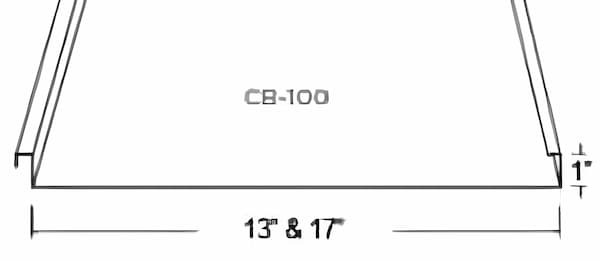
A classic 1-inch mechanical seam with a traditional architectural profile.
The CB-100 panel features a 1-inch mechanical seam in 13-inch and 17-inch widths, making it a strong fit for both residential and light-commercial projects. Its appearance balances a traditional standing seam profile with the durability of a mechanical lock, giving buildings a refined, traditional look. Custom-Bilt Metals offers the CB-100 in 24-gauge steel, 26-gauge steel, aluminum, and copper. Optional Cool Roof colors and natural metals, such as Rheinzink®, help the system support a broad range of architectural styles. The panel can be roll-formed on site to achieve long, uninterrupted runs that eliminate end laps and reduce leak risk. See the Roof Anchor Compatibility Chart for Custom-Bilt Metals CB-100 Standing Seam Panels.
Fall Protection for CB-100 Panels
24-gauge steel seams are compatible with SSRA anchors, while 26-gauge steel, copper, and aluminum versions require ridge-mounted solutions.
On CB-100 systems manufactured from 24-gauge steel, the SSRA products integrate seamlessly. The SSRA1 anchor clamps securely to the seam without drilling. Workers who need a level staging platform can mount SSRA2 Adjustable Roof Jack Adapters above the SSRA1 anchors to support walkboards. Crews handling long roof sections or multiple tie-off points often add the SSRA3 Anchor Plate to help the SSRA HLL 100-Foot Temporary Horizontal Lifeline Kit. Where maintenance teams return frequently, the Super Anchor 120-Foot Permanent Horizontal Lifeline Kit offers a long-term alternative.
Once the CB-100 system shifts to 26-gauge steel, aluminum, or copper, seam compression is no longer safe. Ridge-mounted anchorage becomes the correct approach, and the Ridge Pro Steep Assist Anchor delivers a secure, non-penetrating tie-off before workers place weight on the panels.
SL-1750 Snaplock Panels

A tall 1.75-inch seam with strong definition and broad design flexibility.
The SL-1750 panel features a striking 1.75-inch snaplock-style seam that creates deep, continuous shadow lines from the ridge to the eave. It comes in 14-inch and 18-inch widths and works well on roofs with slopes as low as 3:12. Custom-Bilt Metals manufactures the SL-1750 in 24-gauge and 26-gauge steel as well as aluminum and copper. More than two dozen Cool Roof colors allow designers to blend energy performance with architectural intent. Roll-forming can be completed on site to minimize waste and preserve the finish during installation. See the Roof Anchor Compatibility Chart for Custom-Bilt Metals SL-1750 Standing Seam Panels.
Fall Protection for SL-1750 Panels
Heavier 24-gauge steel panels accept clamp-style anchorage; softer substrates require ridge-based systems.
On 24-gauge steel versions of the SL-1750, workers can use the entire SSRA product family. The SSRA1 anchor provides a dependable, non-penetrating tie-in point, and the SSRA2 adapters provide a level work platform on steep pitches. The SSRA3 Anchor Plate supports the SSRA HLL 100-Foot Temporary Horizontal Lifeline Kit, enabling workers to cross longer spans without losing tie-off protection. Permanent access needs typically lead facility owners to the Super Anchor 120-Foot Permanent Horizontal Lifeline Kit, which installs on mechanically-seamed standing seam roofs for year-round lifeline protection.
For 26-gauge steel, aluminum, or copper SL-1750 panels, the Ridge Pro Steep Assist Anchor provides a reliable tie-off anchor for roof pitches between 6:12 and 12:12.
SLZ-1000 Snaplock Panels

A 1-inch snaplock profile built for quick installation and clean architectural lines.
The SLZ-1000 forms a 1-inch snaplock seam and comes in 13-inch and 17-inch widths. This system offers a clean, contemporary look, fast installation, and strong weather performance. Custom-Bilt Metals produces panels in 24-gauge and 26-gauge steel, as well as aluminum and copper, with Cool Roof options and bare metal finishes. Many installers select the SLZ-1000 for residential or light-commercial work because it can be roll-formed on site, eliminating the need for overlapping seams on long runs. See the Roof Anchor Compatibility Chart for Custom-Bilt Metals SLZ-1000 Standing Seam Panels.
Fall Protection for SLZ-1000 Panels
24-gauge steel snaplock seams can handle SSRA1 anchors and adapters for walkboards and horizontal lifelines.
On 24-gauge steel SLZ-1000 installations, contractors can safely employ SSRA1 anchors along with SSRA2 Roof Jack Adapters and SSRA3 Anchor Plates. The SSRA HLL 100-Foot Temporary Horizontal Lifeline Kit mounts to the SSRA3 plates when crews need wide mobility across the roof. Facilities that rely on recurring roof access often standardize on the Super Anchor 120-Foot Permanent Horizontal Lifeline Kit to simplify annual maintenance.
For 26-gauge steel, aluminum, and copper versions of the SLZ-1000, the ridge-mounted Ridge Pro Steep Assist Anchor ensures a safe, non-penetrating anchor that does not rely on the seam attachment.
SL-100 Nailstrip Panels (Non-Compatible with SSRA Products)
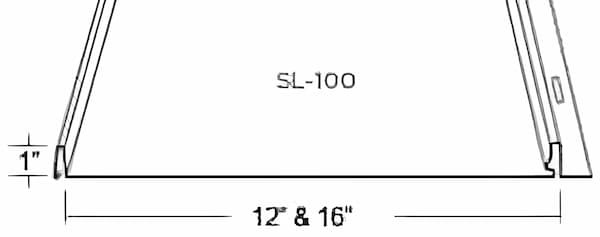
A 1-inch nailstrip profile engineered for fast installation and modern design.
The SL-100 panel features a 1-inch nailstrip seam and is available in 12-inch and 16-inch widths. This system installs quickly and gives buildings a sleek, contemporary look. The SL-100 is available in 24-gauge and 26-gauge steel, as well as aluminum and copper, with a full palette of PVDF Cool Roof colors and elegant bare metals, including copper and Zincalume. Nailstrip seams are common, but they can often pose a challenge for seam-mounted anchors. There are lots of variations in manufacturers and rollforming machines on the same panel; some seams are narrower, and some are wider. If the clamp's set screws cannot squeeze the vertical legs of the seam together, the SSRA1 cannot attach correctly. See the Roof Anchor Compatibility Chart for Custom-Bilt Metals SL-100 Nailstrip Standing Seam Panels.
Fall Protection for SL-100 Panels
Nailstrip seams are not consistently compatible, so ridge-mounted tie-off is required.
SSRA1, SSRA2, and SSRA3 products are not compatible with the SL-100 due to the tapered shape of the seams. The Ridge Pro Steep Assist Anchor is the recommended tie-off method for SL-100 panels, providing a safe, ridge-mounted connection on slopes from 6:12 to 12:12 that doesn't rely on seam attachment.
CS-100 Batten-Cap Panels (Non-Compatible with SSRA Products)
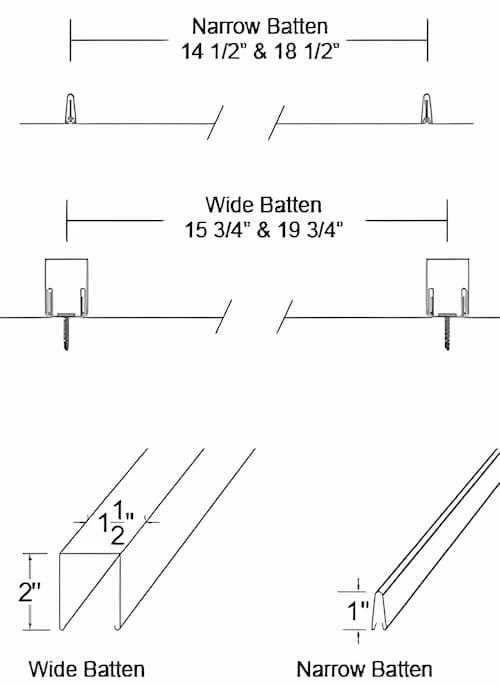
A complete batten-cap assembly built for bold architectural expression.
The CS-100 features a distinctive batten-cap seam available in 14.5-inch and 18.5-inch widths. This profile creates deep vertical lines across the roof and performs well on steep and low-slope applications. Custom-Bilt Metals manufactures the CS-100 in 24-gauge and 26-gauge steel as well as aluminum and copper. PVDF Cool Roof colors and bare metals extend the system's aesthetic range. Because a batten cap fully covers the seam, the panel has no exposed standing seam leg for anchorage. See the Roof Anchor Compatibility Chart for Custom-Bilt Metals CS-100 Batten-Cap Standing Seam Panels.
Fall Protection for CS-100 Panels
Batten-cap seams require ridge-mounted anchorage to preserve seam performance.
Since the batten cap covers the seam entirely, there is no structural location for a clamp-style anchor to engage. SSRA products are not compatible with the CS-100 because doing so requires removing the batten cap or deforming the seam assembly. The safest approach is ridge-mounted fall protection. The Ridge Pro Steep Assist Anchor hooks securely over the ridge. This anchor allows workers to tie off to a vertical lifeline before stepping onto the roof, protecting the cap, the pan, and the concealed clip system beneath.
Curved or radius-formed CS-100 projects need additional evaluation. A qualified fall protection professional should review the roof shape and select the appropriate non-penetrating fall protection system for the job.
Standing Seam Metal Roof Anchor Panel Compatibility Chart For Custom-Bilt Metals
| CB-2000 24 Ga. | CB-150 24 Ga. | CB-100 24 Ga. | SL-1750 24 ga. | SLZ-1000 24 ga. | SL-100 Nailstrip | CS-100 Batten Cap | |
|---|---|---|---|---|---|---|---|
SSRA 1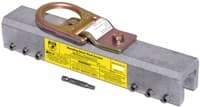 |
NO | NO | NO | NO | NO | NO | NO |
SSRA1 Nylon Tip |
YES | YES | YES | YES | YES | NO | NO |
SSRA2 Roof Jack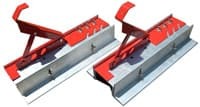 |
YES | YES | YES | YES | YES | NO | NO |
SSRA3 Anchor Plate |
YES | YES | YES | YES | YES | NO | NO |
The Ridge Pro |
YES | YES | YES | YES | YES | YES | YES |
Contact Us for Expert Standing Seam Fall Protection Advice
For expert guidance on standing seam roof anchors, lifeline kits, and fall protection systems that protect both your crew and your panels, contact us today at 863-703-4522 or visit www.StandingSeamRoofAnchor.com. Our safety specialists can help you match the right non-penetrating anchor to your specific roof profile and slope. Let's make your next metal roofing project safe, compliant, and built to last. For continued learning, download OSHA's 48-page Fall Protection Manual and our free Anchor Inspection Form once you've selected the ideal anchors for your roof system. Together, we'll help you stay ahead of OSHA standards while preserving your roof's weather-tight seal.
Safety Tips For Standing Seam Roofs
Equip Workers with High-Quality Safety Gear
High-quality gear is the first line of defense on any project. Crews work more confidently when their harness fits correctly, their Malta Dynamics SRL runs smoothly, and every connector has passed a hands-on inspection before the shift begins. With OSHA giving greater attention to fit, adjustment, and inspection cycles in 2025, safety managers should ensure harnesses match each worker's body type. A properly fitted harness, paired with an SSRA1 or Ridge Pro ridge anchor, becomes the foundation for safe access on every job.
Develop OSHA-Compliant Safety Plans
A detailed safety plan eliminates the guesswork that often leads to serious incidents. Mapping out tie-off locations, defining when to switch from restraint to arrest, and establishing clear rescue procedures gives every worker a task to perform when accidents happen.
Set Up Protective Guardrail Barriers for Work Zones
Guardrails remain one of the simplest and most effective safeguards on large roofing projects. When placed around roof edges, openings, and staging areas, they act as visual and physical boundaries that help crews maintain situational awareness. On larger projects, these boundaries help crews maintain safe movement patterns while focusing on the work at hand.
Ensure Proper Footwear for Stability
Slip-resistant roofing boots with solid ankle support help keep workers balanced. Proper footwear, combined with a secure tie-off to SSRA1 seam anchors or a Ridge Pro ridge point, gives workers a stable three-part safety system: traction, balance, and fall protection.
Use Specialized Anchor Systems for Standing Seam Roofs
Standing seam systems require non-penetrating fall protection anchors. The SSRA1 Standing Seam Roof Anchor grips the seam with stainless steel set screws, without penetrating the seams. That keeps the roof weather-tight and protects the manufacturer's warranty. Many older clamp systems require heavy torque (ft/lbs) or require guessing the location of hidden clips. Avoid both. The precision seam attachment of the SSRA1 anchor with low-torque(in/lbs) set screws preserves panel integrity and ensures a reliable tie-off point. No other fall protection device uses 12 set screws to evenly distribute the load across a 12-inch section of the seam.
Promote a Culture of Safety
A short morning huddle about weather, roof layout, trip hazards, and tie-off strategy sets the tone for the entire day. Crews who talk about close calls or missteps help others avoid repeat scenarios. When installing SSRA1 anchors or moving along steeper roof sections, clear communication can prevent a worker from getting too close to a fall hazard. A strong safety culture turns safe behavior into a habit, not an obligation.
Encourage the Use of Trauma Straps
Stopping the fall is only the first step. Trauma straps give a suspended worker a simple way to shift weight, relieve leg pressure, and maintain circulation while waiting for rescue. Safety managers should treat trauma straps as essential equipment, not an optional add-on. Safety managers should include trauma straps as required equipment for every worker at risk of falling from height.
Consult Experts for Curved Metal Panels
Curved roof systems introduce unique challenges that standard fall protection may not always address. A fall protection specialist can evaluate the roof to determine the safest approach. Expert planning protects both workers and the roof system from damage caused by the wrong anchor choice.
Install Permanent Roof Anchor Systems
Building owners and facility managers often need ongoing access for HVAC service, snow retention checks, or inspections. A permanent option, such as the Super Anchor 120-foot Permanent Horizontal Lifeline Kit, provides maintenance crews with a ready-made tie-off system without roof penetrations. Permanent systems reduce setup time and turn routine access into a simple tie-off process that meets OSHA and ANSI requirements year-round.
Prioritize Ladder Safety Training
Many fall incidents start at the ladder, long before a worker reaches the roof. Ladder training should focus on inspecting the rails and rungs, setting a proper angle using the four-to-one rule, and maintaining three points of contact during every climb. Good ladder habits build safe behavior before a worker ever ties off to an SSRA1 anchor or steps onto a standing seam roof. Crews can avoid common dangerous ladder accidents with regular ladder safety training.
Disclaimer
The views, recommendations, and information presented in this blog are solely those of the author and do not necessarily reflect the opinions or positions of the featured panel manufacturer, its brands, subsidiaries, or parent companies. Customers are strongly encouraged to contact the roof panel manufacturer directly for inquiries regarding fall protection compatibility with their products and to address any potential warranty issues that may arise after installing our products.

